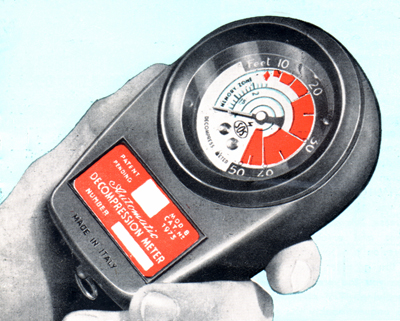MY FIRST (ANALOG) DIVE COMPUTER
© Ian Robertson, 2006
Introduction
All my early dives (from 1959) used the BS-AC tables, closely related to the British Navy Tables of the time. It was only when Cousteau’s book, the Complete Manual of Free Diving, became available in 1960 that we had access to repetitive dive tables. We still had to calculate for maximum depth and total bottom time. There was no way of efficiently computing multi-level dives.


Figure 1. The SOS DCP Dive Computer
Figure 2. How the DCP works
The DCP - how it works
I bought my first analog dive computer or DCP in October 1968 (Figure 1). It was a very simple instrument. Inside, the DCP consists of a small nitrogen-filled bladder, exposed to water pressure, connected, via a porous plug, to a rigid box, with an attached pressure gauge. It is, in fact, a single tissue analogue computer (as opposed to digital) and was made by SOS of Torino, Italy.
Before diving, the content of the box, bladder and gauge are all at atmospheric pressure (Figure 2A). During the dive, nitrogen in the bladder is compressed to the ambient water pressure and nitrogen slowly diffuses through the plug into the box, where the pressure builds up and is recorded by the gauge (Figure 2B). On ascent, when the pressure in the box is greater than in the bladder, nitrogen diffuses outwards through the plug, the pressure in the box decreases slowly, and this is shown by a falling gauge pressure. The gauge has a no decompression zone (Figure 3) but, when decompression is required, it progressively indicates decompression depths of 10, 20 and 30 feet etc (Figure 2C). You just stay at the indicated depth until the gauge indicates a lesser depth. There was no indication, at all, as to how long the stop would be. Final ascent is only allowable after more decompression, if the dive was long or a repetitive dive. After the dive, residual nitrogen continues to diffuse slowly outwards (Figure 2D) over the surface interval for six hours or more (pressure group) and the pressure in the gauge falls slowly through the no decompression zone. Another dive within this time takes you into decompression sooner.
How good was it?
In its own analogue way, it mimics the behaviour of nitrogen in the body – simplicity itself. It manages repetitive dives and multilevel dives and was a significant advance in diver instrumentation at the time. It did not compute for a host of tissue half lives, as do the modern digital dive computers. Today, it would be seen as a bit short on options and a bit dodgy, but it had no battery to go flat and it was all we had at the time.
The big question was could it be trusted? The Italian Navy Tables, on which it was presumably based, were regarded as a tad ‘gung-ho’. I ran it in parallel with conventional decompression tables for several dives, including dives in the 45-55 m zone, only trusting the tables but found the DCP gave quite credible results, if a little less conservative than the tables I relied upon. However, most actual dives have a multi-level component and I felt my direct comparisons with the tables might be a little unfair.

A month later, I had an ideal opportunity to test it more thoroughly. While employed as a diver’s attendant and recompression chamber operator on an engineering project at the Kariba Dam, I had a lot of time on my hands, waiting on the barge for divers to surface. I tied the DCP to a weighted 60’ (18 m) line and suspended it in the deep water below the barge for the exact time it would take to reach the no decompression limit at 60 ft according to the British Navy Tables. The Brit tables were more conservative than the US Navy tables and definitely more conservative than the Italian tables. When the time was up, I quickly hauled it to the surface (something you can do to an instrument but not to a diver). The needle indicated a point between the A and the C of ‘SURFACE’ in the no decompression zone (Figure 3).
Figure 3. The revised no decompression point
Using this revised and conservative no decompression point, I continued to use the DCP as a no decompression device only, and stuck to BS-AC tables for serious decompression diving. As most of my dives were no decompression dives (albeit with long safety stops), this was a very handy gadget. It accompanied me on almost all my subsequent dives (over 200) to 1977 and it never let me down. Sadly, it hit the bin in a 1990's fling-out, but I still have its manual.
It was not as fancy as the multi-tissue electronic digital computer we have now, with LCD display, which still is the single most fantastic advance I saw when I returned to diving after a break from 1977-1996. Remember that any dive computer, from the most simple to the most complex, is still just an approximation, so use them with caution.